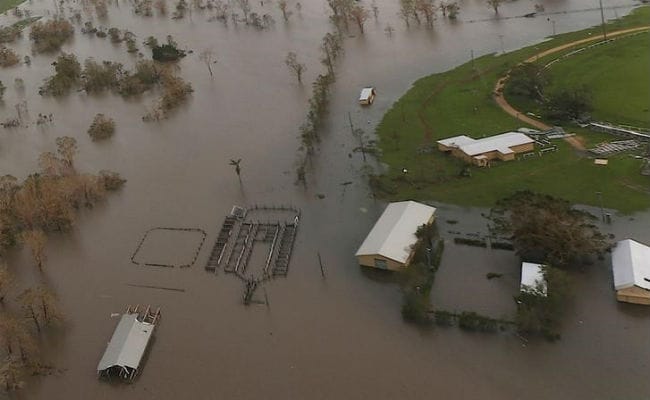
Local residents wade through floodwaters near their homes in Lismore. (Reuters)
Sydney:
Tens of thousands of Australians were stranded by floodwaters on Saturday after the remnants of a powerful cyclone swept along the country's east coast, cutting roads, destroying bridges and killing two people.
The disaster zone from ex-Cyclone Debbie stretched 1,000 km (600 miles) from Queensland state's tropical resort islands and Gold Coast tourist strip to the farmlands of New South Wales state, with more than 100,00 homes without power.
Six large rivers had hit major flood levels and were still rising in several areas, said the Bureau of Meteorology.
Flood sirens sounded in several towns, prompting stranded residents to climb onto roofs of flooded homes to await rescue, but fast-moving water and high winds hindered emergency crews reaching several areas.
 Police said they recovered the bodies of two women from floodwaters late on Friday, the first reported deaths since Cyclone Debbie hit on Tuesday. One was found on a swamped property and the other retrieved by police divers from a car that had been swept off a flooded bridge.
Police said they recovered the bodies of two women from floodwaters late on Friday, the first reported deaths since Cyclone Debbie hit on Tuesday. One was found on a swamped property and the other retrieved by police divers from a car that had been swept off a flooded bridge.
Authorities fear more people may have died overnight as floodwaters continued to rise.
Cyclone Debbie, a category four storm, one short of the most powerful level five, pounded Queensland state on Tuesday, smashing tourist resorts, bringing down power lines and shutting down coal mines.
Debbie will hit Australia's A$1.7 trillion ($1.3 trillion) economy, with economists estimating it will slow growth to under 2 percent in the first quarter.
In the Bowen Basin, the world's single largest source of coal used in steel-making, Glencore said its mines were not damaged by the storm but restarting production depended on railways reopening.
Three of rail operator Aurizon's four railway lines in the region were closed and BHP was assessing the extent of disruption to shipments.
Queensland's top insurers, Suncorp Group Ltd and RACQ, said it was too early to put a dollar figure on the damage.
(Reporting by Jane Wardell; editing by Andrew Roche)
The disaster zone from ex-Cyclone Debbie stretched 1,000 km (600 miles) from Queensland state's tropical resort islands and Gold Coast tourist strip to the farmlands of New South Wales state, with more than 100,00 homes without power.
Six large rivers had hit major flood levels and were still rising in several areas, said the Bureau of Meteorology.
Flood sirens sounded in several towns, prompting stranded residents to climb onto roofs of flooded homes to await rescue, but fast-moving water and high winds hindered emergency crews reaching several areas.

6 large rivers had hit major flood levels and were still rising in several areas of Australia. (Reuters)
Authorities fear more people may have died overnight as floodwaters continued to rise.
Cyclone Debbie, a category four storm, one short of the most powerful level five, pounded Queensland state on Tuesday, smashing tourist resorts, bringing down power lines and shutting down coal mines.
Debbie will hit Australia's A$1.7 trillion ($1.3 trillion) economy, with economists estimating it will slow growth to under 2 percent in the first quarter.
In the Bowen Basin, the world's single largest source of coal used in steel-making, Glencore said its mines were not damaged by the storm but restarting production depended on railways reopening.
Three of rail operator Aurizon's four railway lines in the region were closed and BHP was assessing the extent of disruption to shipments.
Queensland's top insurers, Suncorp Group Ltd and RACQ, said it was too early to put a dollar figure on the damage.
(Reporting by Jane Wardell; editing by Andrew Roche)
© Thomson Reuters 2017
Track Latest News Live on NDTV.com and get news updates from India and around the world

